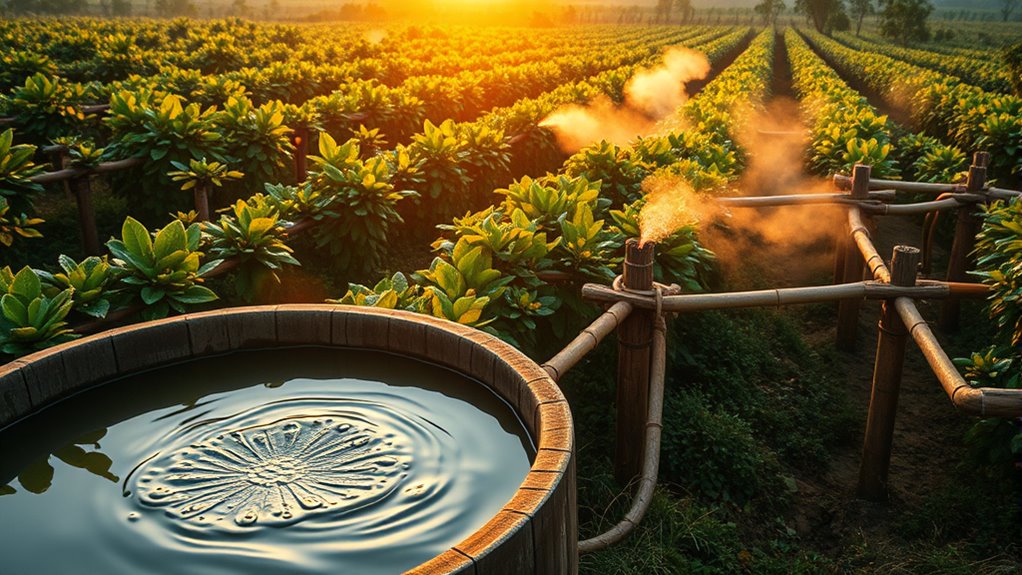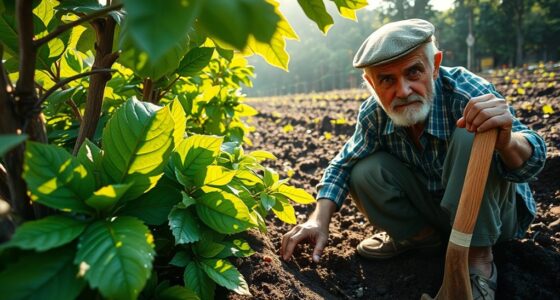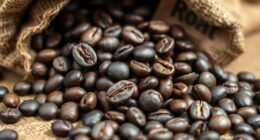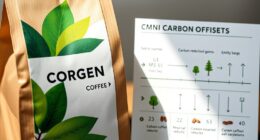The water used to produce your coffee is a major environmental concern, with each cup requiring about 140 liters of water. Regions like Brazil face water stress due to intensive farming, and wastewater from processing can pollute ecosystems. Sustainable practices, innovative technologies, and consumer choices can help reduce this impact. If you’re curious how the industry is addressing these challenges and what options are available to make your coffee consumption more eco-friendly, there’s much more to discover.
Key Takeaways
- Coffee cultivation accounts for over 99% of virtual water, impacting regional water resources.
- Water-intensive wet processing can deplete local water supplies and cause pollution.
- Sustainable practices like wastewater recycling and drought-resistant cultivars reduce water consumption.
- Industry certifications promote water conservation and environmentally friendly farming methods.
- Consumer choices, such as reusable cups and sustainable sourcing, influence water footprint reduction.
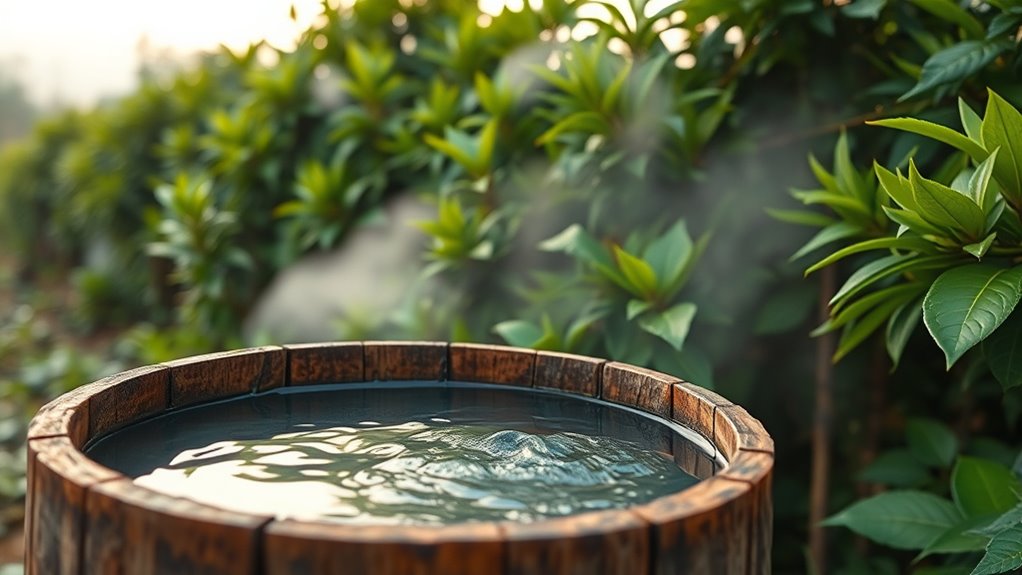
Coffee production consumes a significant amount of water, often unnoticed by consumers. Every time you enjoy your favorite brew, behind the scenes, a complex process demands thousands of liters. On average, a standard cup of coffee requires about 140 liters of water, which includes everything from cultivation to processing and transportation. If you consider Switzerland’s 2018 coffee consumption alone, it accounts for an astonishing 13 trillion liters of water annually—roughly equivalent to filling 5.2 million Olympic-sized pools. This immense water footprint highlights how much resource is embedded in your daily caffeine fix.
Most of this water use occurs during the agricultural stage, where over 99% of the virtual water content is concentrated. In coffee-growing regions, this can lead to regional water stress, especially in areas already facing scarcity. For example, in Brazil, wet processing—a method that improves bean quality—requires about 3,028 cubic meters of water per ton of coffee, used for pulping, washing, and fermentation.
In contrast, dry processing, which relies on natural drying without water, minimizes water use but might affect coffee quality. Some producers are adopting semi-washed or honey processing, which reduces water consumption by only partially fermenting beans, and mechanical demucilaging further cuts water use by approximately 74%.
Furthermore, innovative water management practices such as recycling wastewater and optimizing irrigation schedules are gaining traction to reduce overall consumption. However, these methods pose environmental challenges. Wastewater generated from pulping and washing contaminates local water sources, leading to pollution and risking eutrophication in nearby ecosystems. Chemical runoff from pesticides and fertilizers also harms aquatic life and degrades soil health, reducing land productivity over time.
Regions dependent on coffee cultivation, like Ethiopia and Vietnam, face additional pressures—Ethiopian farmers are turning to solar drying to lessen water reliance, while Vietnamese farms grapple with groundwater depletion caused by intensive irrigation.
Industry responses aim to mitigate these impacts. Organizations like Fairtrade and Rainforest Alliance promote water conservation practices, and partnerships with groups like WWF support wastewater treatment infrastructure. Technological innovations, such as hydrodynamic separation and precision irrigation using soil moisture sensors, help optimize water use.
Some companies are also experimenting with blockchain to trace water footprints across supply chains, encouraging sustainable choices.
Your role as a consumer can influence these practices. Choosing coffee with sustainable certifications signals demand for water-efficient production. Using brewing methods that minimize water waste, such as espresso machines, and reusable cups further reduces your indirect water footprint.
Additionally, paying a premium for sustainably sourced coffee often funds water infrastructure improvements in producing regions, creating a positive cycle of conservation.
As awareness of water’s hidden role in coffee production grows, so does the potential for innovation and responsible consumption. Future technologies like biofilters and drought-resistant cultivars promise to reduce water dependence further.
Ultimately, understanding the water embedded in your coffee can inspire more mindful choices that support both quality and sustainability.
Frequently Asked Questions
How Does Water Usage Vary Among Different Coffee-Growing Regions?
You should understand that water usage varies widely among coffee-growing regions due to climate, geography, and farming practices.
In Latin America, abundant rainfall reduces irrigation needs, while African regions may rely more on irrigation in drier areas.
Asian countries have diverse climates, leading to different water requirements.
Mountainous areas often need less water, thanks to natural rainfall, whereas flat regions may depend heavily on irrigation for successful coffee cultivation.
What Are Alternative Methods to Reduce Water Consumption in Coffee Farming?
To cut water use in coffee farming, you can adopt alternative methods like installing drip irrigation systems that target plant roots directly, reducing evaporation and runoff.
Harvest rainwater with roof catchment systems and store it for dry periods.
Implement soil moisture management techniques such as mulching and sensor-based watering schedules.
Additionally, promote agroforestry practices and ecosystem restoration to improve water retention naturally, making your coffee farm more sustainable and water-efficient.
How Does Water Pollution Impact Local Ecosystems Near Coffee Plantations?
You should know that water pollution from coffee plantations harms local ecosystems by contaminating rivers and streams with waste and chemicals. This can kill aquatic life, disrupt habitats, and reduce biodiversity.
Soil erosion from monoculture practices increases sediment in waterways, damaging habitats further. Additionally, chemicals used in farming can be toxic to plants and animals, leading to long-term ecological damage and threatening the health of the entire environment surrounding coffee farms.
Are There Certifications Indicating Low Water Usage in Coffee Production?
Imagine lush coffee plantations thriving with minimal water waste, thriving ecosystems pulsing with life.
Currently, there are no widely recognized certifications specifically indicating low water usage in coffee production.
While certifications like Organic or Fair Trade promote sustainable practices, they don’t focus solely on water efficiency.
To truly reduce water consumption, adopting advanced irrigation tech and integrating water-saving practices are more effective than relying solely on certifications.
What Role Does Climate Change Play in Water Availability for Coffee Cultivation?
Climate change profoundly impacts water availability for coffee cultivation. You’ll find erratic rainfall patterns, droughts, and intense storms disrupting water supply, stressing plants, and reducing yields.
Rising temperatures increase evaporation, making it harder to maintain soil moisture. These changes force you to adapt with strategies like drought-resistant crops and precision irrigation.
Without action, models predict up to 50% of coffee land could become unsuitable by 2050, threatening your coffee future.
Conclusion
As you enjoy your favorite coffee, remember that each sip is tied to a vast web of water use. The question isn’t just about taste, but about sustainability—will future generations savor the same brew if we don’t act now? Water, like life itself, is a precious resource. So, next time you reach for that cup, think about how your choices can make a ripple—turning the tide toward more responsible coffee production and a healthier planet.
